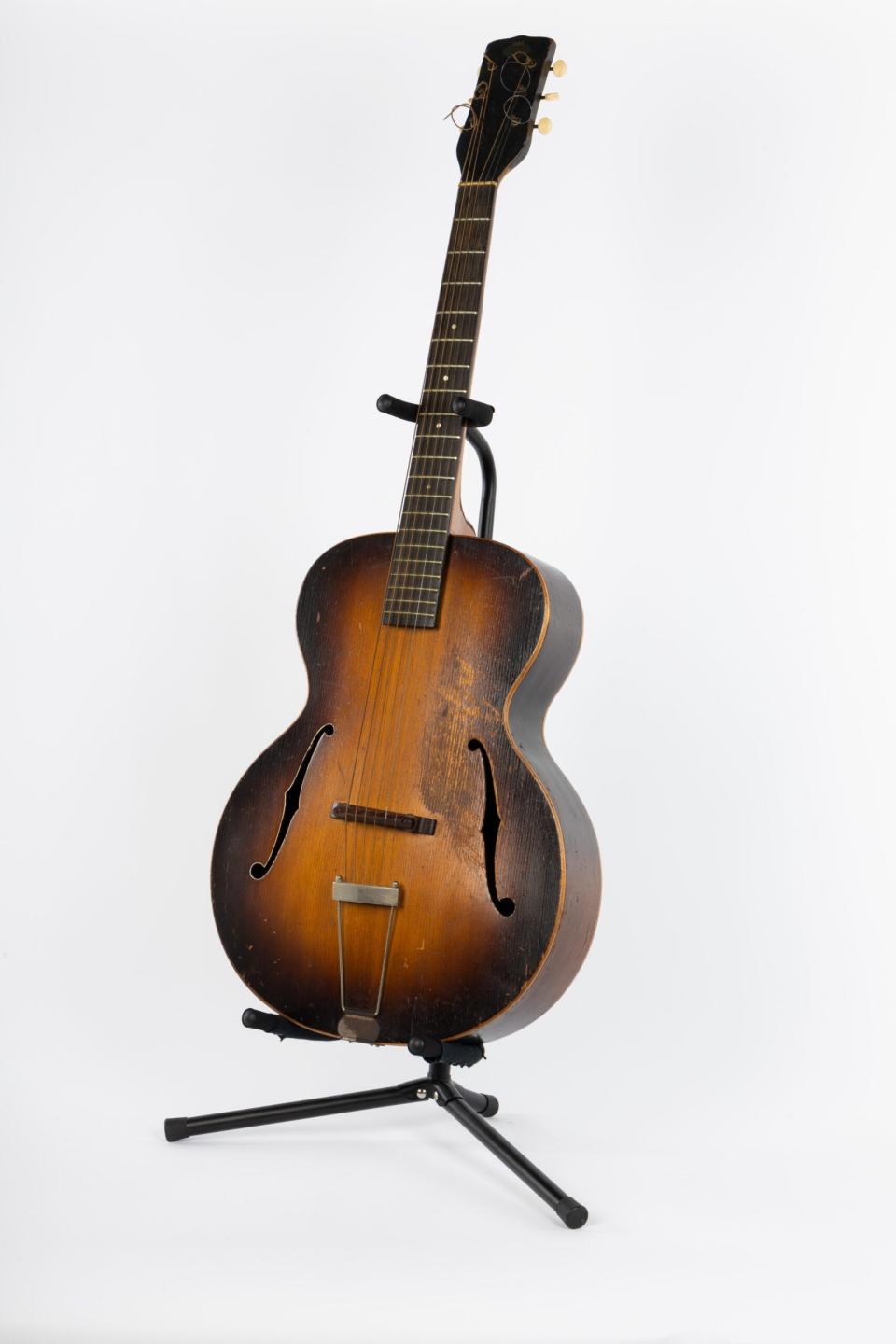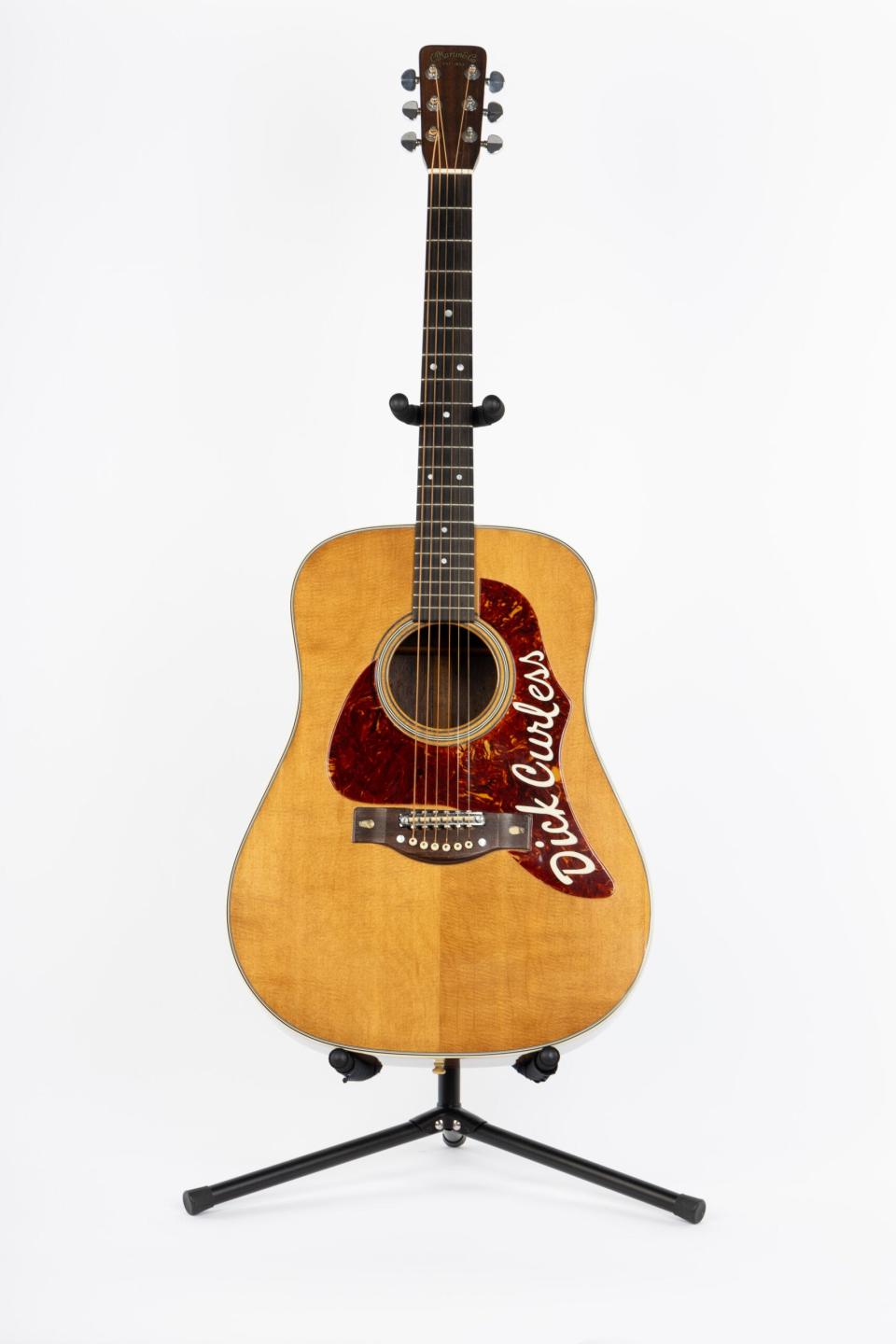Dick Curless, 'A Tombstone Every Mile' vocalist, celebrated at Country Music Hall of Fame and Museum
- Oops!Something went wrong.Please try again later.
An eye-patch-wearing country music performer with 12 Top 40 singles in ten years is being celebrated at the Country Music Hall of Fame and Museum. If the name in question was anyone other than Dick Curless, questioning the organization's and venue's curatorial standards would make sense.
His top-five smash, 1965's "A Tombstone Every Mile" refers to vegetable truck drivers failing to navigate a hairpin turn in the Haynesville Woods section of Aroostook County in northern Maine. Given that Jan and Dean's "Dead Man's Curve" was a pop hit a year prior, Curless' soulful baritone cautioning about a road that's "never ever ever seen a smile" feels appropriate to the era.
The truck driving anthem spent 17 weeks on Billboard's charts and reached the top five during a time when Roger Miller singing about a hobo being "King Of The Road" was all the rage in country music.

Curless' legacy was celebrated at the downtown Nashville venue on Feb. 18 during a 90-minute ceremony featuring Peter Guralnick, award-winning author and exhibition guest co-curator, his son, Jake Guralnick, who produced Curless' final release in 1995, plus Chuck Mead, co-founder of country band BR549 and Americana solo artist.
Before the event, The Tennessean spoke to Peter Guralnick and Mick Buck, the Curatorial Director at the Country Music Hall of Fame and Museum.
In an era where one-hit wonder mainstream country success is easier than ever while attempting longevity feels a much more arduous goal, Curless' four-decade-long career -- while short on Billboard chart-toppers, but long on critical appreciation -- is important to chronicle as a template.
In an era where the Americana subgenre honors the country's many root inspirations, highlighting artists who missed the music industry's evolution that allowed those sounds to gain significant commercial credence is noteworthy.
"In my opinion, [Dick Curless] was a major artist who stands on the same plateau as his contemporaries and admired influences. To wit, Guralnick peppers the rest of the conversation with a list of diverse artists including Gene Autry, Johnny Cash, Lefty Frizzell, Merle Haggard, Hawkshaw Hawkins, Jimmie Rodgers, Merle Travis, Josh White, or Hank Williams.
"He had a rare breadth and depth to his music that allowed the listener to become totally invested in his songs," Guralnick adds.
"If Dick were a young artist today, he'd be a pillar of the Americana community. He'd have a large audience and be hailed as one of the industry's most honest artists."

Via Buck, the Country Music Hall of Fame and Museum has been attempting to curate an exhibition of Curless' personal effects since 2019.
He notes that the musician's daughter, Terry, had contacted the museum about a large collection of her father's memorabilia she had stored at her home outside of Portland, Maine. Interested, Buck visited the home, examined the "vast" collection, then began the process of scheduling the now-showcased exhibition.
Music chronicler Guralnick's October 2020-released "Looking to Get Lost: Adventures in Music and Writing" features three decades of his research into Curless' legacy, alongside essays and profiles about many musicians he has encountered in his lifetime.

Alongside his son -- and noted record producer Jake Guralnick -- he spent time with Curless in the studio as he created his final, studio-recorded album, 1995's "Traveling Through."
Notably, Guralnick highlights that central to understanding Curless' career is understanding how his roots play into how Nashville often discriminated against rougher, folk-defined, coastal-based artists during the "Nashville sound" era.
Curless was born to a family that emigrated from Canada's Maritime provinces to northern Maine.
Buck describes the United States' northeasternmost state as having a "vital history and tradition" in country music highlighting 1950s-era stars like racially mixed bluegrass duo, Allerton & Alton, "Yodelin'" Slim Clark, married regional duo Hal Lone Pine and Betty Cody.
Had Curless not served in the Korean War from 1952-54, it's entirely likely he would've seen the same acclaim afforded the previously mentioned performers.
However, though, country music's ability to overcome coastal biases moved west, then eventually east. However, this occurred long after the portions of Curless' career that saw him eventually chase success both out west in Bakersfield and Los Angeles, via being signed to Buck Owens' management, production, and publishing company, leading to time spent in and out of Music City while signed to Capitol's blues and rawer rock-driven Tower Records subsidiary from 1965-1970.
He was a gospel and jazz-inspired player whose tastes deviated into blues, country and folk. Thus, for Nashville, past the trucker-era novelty of typecasting his work alongside Dave Dudley (1961's "Six Days On The Road") and Red Sovine (1965's "Giddyup Go"), his finger-picking, funky, rhythmic guitar influences fell just outside of the purview of the larger, pop-aimed country environment.

The Maine-born performer's artistic style is described by Guralnick as a "uniquely personal" one that the author notes the artist himself describes as chronicling "life itself -- not happily ever after and the white picket fence, but instead, the peak and valleys."
Country music of the late 1960s that achieved popular acclaim was defined by a particular type of smooth ease and sometimes troublesome lyrics. Comparatively, Curless' sound falling outside of that expectation placed him on a label where songs like The Standells' "Dirty Water" and songs by second-wave British Invasion acts like Freddie and the Dreamers (1964's "I'm Telling You Now") and Tom Jones represented his competition.
Between 1965-1995, Curless' contemporary Haggard achieved six times as many top-40 country singles as the "Hard Traveling Man From Maine" -- including 15 No. 1 singles (out of 20 singles released) between 1971-1976.

Regarding the driving forces apparent in Haggard, not as apparent -- in Guralnick's estimation -- in Curless, that spurred that success, the author states the following:
"[Dick] didn't have that ambition, inner drive and refusal to agree to the demands of the label system. Dick had a 'go along to get along' element to his character where even if he had inner misgivings, he still agreed with what executives asked him to do."
Still, though, he was the kind of artist who, when he once played an unreleased song for Buck Owens before a show at a hockey arena in Northern Canada, caused the country icon to exclaim, "I hate you, I hate you!," because his talent as an expresser and interpreter of emotion was so profound.

By 1995's 15-track "Traveling Through," he wholly re-embraces that funky, rhythmic, rootsy style, now timelessly his own. Sadly, he was -- after serious eye problems impaired his vision in the late 1960s -- stricken with stomach cancer and died in May 1995.
A review from the era notes that the album's "emotional and sentimental" sound would feel comfortable "at an American Legion hall or a roadhouse," featuring "a rich, soulful and warm voice" reminiscent of Ray Price, that's equally as sonorous on blues and rockabilly songs.
In short, Buck adds, "["Traveling Through"] is [Curless'] greatest artistic statement, the high point of his musical output."
When asked to summarize Curless' importance to Americana's burgeoning traditions and country music's overall history, Peter Guralnick adds a poignant note.
"Far more significant than commercial trends, country music's ability to impact people's lives is of utmost importance. Dick's music stands the test of time because -- at his best -- he's expressing his innermost self with extraordinary artistic depth and reach, instead of being caught up in chasing fame's momentary acceptance."
This article originally appeared on Nashville Tennessean: Dick Curless, 'A Tombstone Every Mile' vocalist, celebrated at Country Music Hall of Fame and Museum

